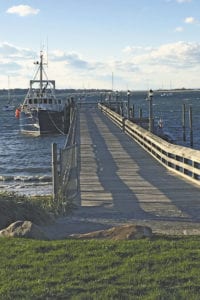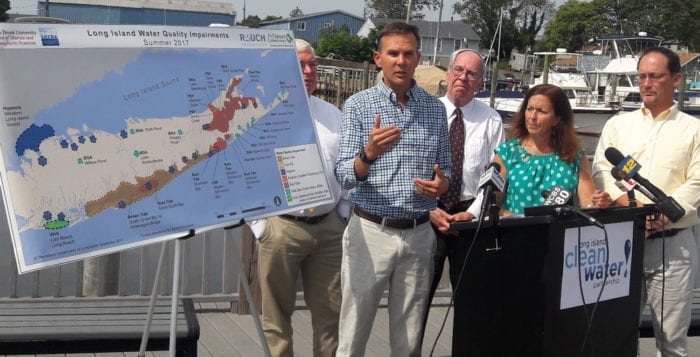By Kyle Barr
There’s still something in the water — and it’s not a good kind of something.
Scientists from the Stony Brook University School of Marine and Atmospheric Sciences released an annual report highlighting the concern over the prolonged existence of toxic algae blooms, and a deficiency of oxygen in Long Island waters caused high levels of nitrogen.
Stony Brook Professor Christopher Gobler and several members of the advocacy collective Long Island Clean Water Partnership, a conglomerate of several Long Island environmental groups, revealed the findings of a study done from May to August.

“In order to make Long Island sustainable and livable, clean water needs to be established,” said Adrienne Esposito, the executive director of Citizens Campaign for the Environment. “The challenge has been very great over the last decade … though the problem, unfortunately, is getting a bit worse. Algae blooms and the degradation of water quality across Long Island are serious threats to Long Island’s health.”
On the North Shore, there are several severe cases of hypoxia, or a depletion of dissolved oxygen in water, which is necessary for sea life to survive. Cases were found in Stony Brook Harbor, Northport Bay, Oyster Bay and Hempstead Bay. Measured on a milligram per liter of water scale,any case of hypoxia below two milligrams per liter can be harmful to fish, and almost anything else living on the bottom of the bays.
There were also periodic outbreaks of blue-green algae in Lake Ronkonkoma and Stony Brook University’s Roth Pond. This algae releases a poison harmful to humans and animals, but Gobler said students at the university shouldn’t worry, because he and other scientists at Stony Brook are constantly monitoring the water, especially before the annual Roth Regatta.
“[If nothing is done] the areas could expand — it could get more intense,” Gobler said. “We use a cutoff of three milligrams per liter, which is bad, but of course you can go to zero. An area like Hempstead Harbor went to zero, [Northport and Oyster Bays] went to zero at some points in time. There’s a usual day-night cycle, so it’s at night that the levels get very, very low.”
“We have the problem growing worse, and it is going to get worse before it gets better.”
—Dick Amper
As a result of the possibility of hypoxia expanding, Gobler said he and other scientists have also been monitoring Port Jefferson Harbor and Setauket Harbor.
Though Setauket Harbor is not currently experiencing any problems with hypoxia or algae, the harbor has experienced periods of pathogens, like E. coli, some of which were born from runoff into the harbor, but others might have come from leakage of antiquated cesspools in the area, according to George Hoffman, a trustee of the Setauket Harbor Task Force, which is also a member of the Clean Water Partnership.
Next May the task force hopes to start monitoring directly inside Setauket Harbor. Runoff from lawn fertilizers can also increase the nitrogen levels in the harbor.
“If our problem isn’t hypoxia, we have a problem with pathogens,” Hoffman said in a phone interview. “Prevention is really [Dr. Gobbler’s] goal — to know what is happening and to start taking steps. I think people’s information levels [on the topic] are high in the surface waters that they live by.”
In addition to hypoxia and blue-green algae, some of the water quality problems found in the assessment were brown tides on the South Shore, rust tide in the Peconic bays and paralytic shellfish poisoning on the East End — all of which are also nitrogen level issues that can be traced back to cesspool sewage and fertilizers.

“Make no mistake about it, this is so big that even … still, we have the problem growing worse, and it is going to get worse before it gets better,” said Dick Amper, the director of The Long Island Pine Barrens Society. “What’s the solution to this problem? We have to do more.”
There have been several efforts to help curb water degradation on Long Island. New York Gov. Andrew Cuomo (D) signed legislation in April that put $2.5 billion toward clean water protection, improving water infrastructure and building new sewer systems in Smithtown and Kings Park, and adding a rebate program for those upgrading outdated septic systems.
Despite doing more, the repairs will take some time.
“This is going to be a long, long marathon,” said Kevin McDonald, the conservation project director at The Nature Conservancy said.
There is also worry that the U.S. Army Corps of Engineers — announcing the dumping of dredged materials into Long Island Sound — could compound the problem.
“We have more political funding and will try to implement solutions,” Esposito said. “The problems are getting worse, but the solutions are becoming clearer.”





